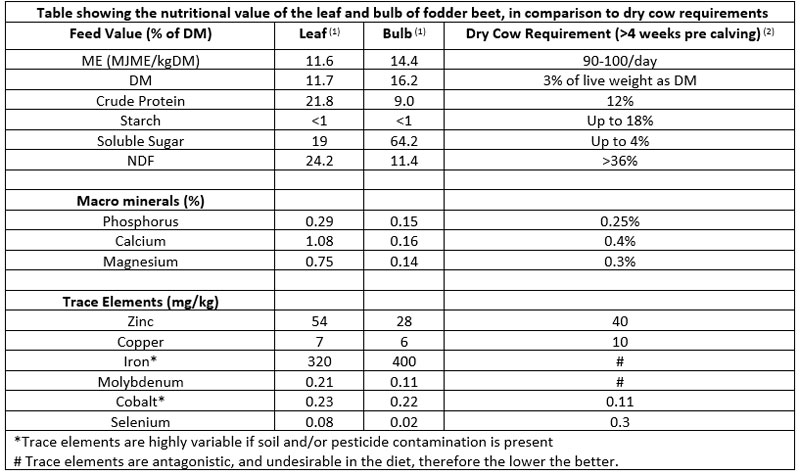Feeding Fodder Beet
The feasibility of feeding fodder beet has been debated for several years now. On one hand, it is a potentially high-yielding crop great for keeping stock fed in hard winter conditions. On the other hand, if not managed well, it can lead to serious short-term and long-term animal health issues. Understanding the nutritional and animal-related pros and cons of this crop is important when making winter crop decisions.
The Pros and Cons
Yield: Fodder beet is a fantastic crop for achieving potentially a high dry matter yield per hectare when compared to its alternatives- in some cases over 30TDM/ha. This provides two main advantages: firstly, less area is taken out of the pasture and turned into ‘unusable’ area while the crop is out of action. Secondly, while the crop is being grazed it acts as a sacrifice area, thus reducing damage to the rest of the farm during the wet. However, the downside to this is significant soil damage can be caused in the crop paddocks, although this may not be a problem if the paddock is due for a revamp.
Feed Value: Fodder beet leaves are relatively well balanced; however, the leaf-to-bulb volume can vary from 10%-30% of the crop. Fodder beet bulbs are extremely high in sugar- while that makes them very tasty when combined with their lack of effective fibre, it makes them a serious contender for causing ruminal acidosis if not managed properly. Furthermore, the bulbs contain around 9% crude protein, which is not high enough to support foetal development in pregnant animals, nor lean muscle growth in young stock. On the positive side, the crop is very high in metabolisable energy (MJME/kgDM) and is therefore quite effective for achieving rapid gains in body condition.
Macro Minerals: The tops of fodder beet provide more than enough macro minerals for a dry cow, however the bulbs are seriously deficient in phosphorus, calcium and magnesium. In the short term, this may impact appetite, weight gain, energy levels, and growth rates young stock. In the long term, these deficiencies can be compounded causing issues such as milk fever at calving, ‘creeper cow’ – a phosphorus deficiency, poor milk production, delayed cycling, and brittle bones in young stock.
Trace Elements: Once again, the leaf portion of the crop meets requirements in some areas, however the bulbs fall dramatically short in crucial trace elements such as copper and selenium. These shortfalls can be further exacerbated by the ingestion of soil as it contains iron, which is an antagonistic trace element that inhibit the absorption of many beneficial trace elements in ruminants. Deficiencies in these trace elements are often not noticed until it is too late, and results can include retained foetal membranes, compromised immunity and poor reproductive performance come mating time.
Top Tips for Managing Fodder Beet
Allocation: It is worthwhile getting a dry matter test done on the crop to ensure feed allocation can be accurately estimated. This is especially important for the transition period, or in a restricted volume system, to make sure the herd is actually eating the volumes calculated.
Transitioning: Transition all animals onto the crop over a 2-week period (minimum), introducing the fodder beet at 1kg/h/day, and adding an additional 1kgDM/h/day every second day, ensuring that the entire herd is getting their allocation. Also, be sure to feed stock an alternative supplement such as silage 2-3 hours prior to going on to the fresh crop so they are not hungry and at risk of binge eating. Transitioning is crucial, as it allows for the rumen to adapt to digesting the high volume of rapidly fermentable sugar, thus reducing the risk of acidosis.
Fibre + Protein: Always having adlib effective fibre available will go a long way to helping manage animal health. Ensuring sufficient effective NDF in the diet helps manage rumen function and pH. Furthermore, using a pasture or legume-based silage will also boost the protein content of the diet enough to support lean muscle growth and/or foetal development.
Macro and Micro Mineral Requirements: Supplementing the necessary macro and micro minerals is a non-negotiable, however, it can be tricky to supplement non-lactating animals in wet conditions. The Seales Winslow Cattle Fodder Beet Block is an ideal low-labour, weather-proof option. Available in both 25kg tubs or 500kg ‘bricks’, this molasses-based lick block has been formulated to meet the macro and mineral deficiencies typical in NZ fodder beet, particularly phosphorus. By keeping this product in both the crop paddock and any other stand-off or grazing areas, the cattle have a consistent supply of minerals, 24 hours a day. Perfect for aiding in the prevention of any potential animal health issues on the horizon.
For more information regarding management practises and product solutions for fodder beet, talk to your local TSR or call customer services today on 0800 2873285.

1. Laboratories, Hills. Mineral result data for fodder beet bulbs and tops. Hills Laboratories. [Online] Feburary 2020. https://www.hill-laboratories.com/about-us/news/fodderbeet-mineral-content-remains-unchanged/.
2. Lean. I., and DeGaris, P. Transition Cow Management; a review for nutritional professional, veterinarians and farm advisers. s.l. : Dairy Australia, 2010.

